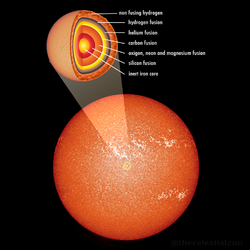Astronomy:L-type supergiant

L-type supergiants are an extremely rare type of supergiant star that have spectral types of "L" due to their low temperatures. Such stars should be very unstable due to the extremely low density and temperature but can exist for short periods of time. A star that may eventually become an L-type supergiant starts as a B- or late O-type main sequence star (7-~25 solar masses) and evolves off the main sequence, up and to the right on the H-R diagram. It may expand by up to a factor of 300 and cool dramatically in the process due to the laws of thermodynamics, reaching spectral type M10 at ~2,400 K and cooling into the L-type range. An L-type supergiant can also form when a pair of hotter, sometimes main-sequence stars undergoes a luminous red nova explosion preceding or during the transition from B-type main sequence star to B or A-type giant to orange or red supergiant, such as in the case of V838 Monocerotis. Some sources also claim that V838 Monocerotis was an extremely unusual main-sequence star, with a temperature of 7300 K and a luminosity less than twice the Sun's, corresponding to an F-type or G0 star.[2] Examples are VX Sagittarii and V838 Monocerotis at their coolest.[3][4][5][1] These stars have huge extended atmospheres that can reach past the orbit of Jupiter.[6]
Spectral properties

An L-type star (any star, not just a dwarf one) is distinguished from M10s and T0s by its prominent alkaline metal (Na I, K I, Cs I, Rb I) and metal hydride (FeH, CrH, MgH, CaH) emission bands.[4] V838 Monocerotis even had water bands in its atmosphere at the peak of its eruption, suggesting a T- or Y-type star with a temperature of ~1500 K or less.[2] L-type stars are so cool that titanium oxide, present in the lines of M stars, has disappeared from the stars' spectrum, congregating into hot dust in their chromospheres.[7] When L-type supergiants are observed, spectral lines are mostly inferred from the infrared part of the spectrum due to the extremely low temperature and therefore high peak wavelength.[8]
Color
- The apparent color of an early L star is deep scarlet, whereas mid- and late L stars are dull reddish pink. There are no brown stars.[9][10]
Evolution

L-type giant and supergiant stars form when a normal star undergoes a luminous red nova or expands to the point where it cools into the brown dwarf range. The transition is usually extremely quick (for a star) and can occur within a matter of years.[2] V838 Monocerotis reached ~L3 at its coolest, with a temperature of 2000-2200 kelvins, while also expanding to 1,500 solar radii or larger during the peak of its 2002 eruption.[1] The type L0 milestone was reached just before Halloween 2002.[11] VX Sagittarii is believed to be an asymptotic giant star or super-AGB star, despite its extremely high luminosity (195,000 suns) and radius (~1,500 suns), meaning L-type giants can form as well as supergiants, but not in Sun-like stars, mostly in more massive stars (6-10 solar masses, ~B0-B4).[12]
A star called M31-RV underwent a luminous red nova eruption in 1988, but only reached spectral type M7 at its coolest. While this is extremely cool for a red supergiant, it also demonstrates that not all luminous red novae become L supergiants.[13]
L supergiants and their respective luminous red novae can form from collisions of virtually any star, even a red dwarf or Sun-like star, and some scientists theorize that V838 Monocerotis was once a pair of one G-type and one very low-mass star.[2]
See also
- Betelgeuse
- Antares
- Hypergiant, the largest type of star around today
- Quasi-star (early-universe)
References
- ↑ 1.0 1.1 1.2 Loebman, S. R.; Wisniewski, J. P.; Schmidt, S. J.; Kowalski, A. F.; Barry, R. K.; Bjorkman, K. S.; Hammel, H. B.; Hawley, S. L. et al. (2015). "The Continued Optical to Mid-Infrared Evolution of V838 Monocerotis". The Astronomical Journal 149 (1): 17. doi:10.1088/0004-6256/149/1/17. Bibcode: 2015AJ....149...17L.
- ↑ 2.0 2.1 2.2 2.3 Evans, A.; Geballe, T. R.; Rushton, M. T.; Smalley, B.; Van Loon, J. T.; Eyres, S. P. S.; Tyne, V. H. (2003). "V838 Mon: an L supergiant?". Monthly Notices of the Royal Astronomical Society 343 (3): 1054–1056. doi:10.1046/j.1365-8711.2003.06755.x. Bibcode: 2003MNRAS.343.1054E. https://www.researchgate.net/publication/227732246.
- ↑ admin (2020-09-13). "VX Sagittarii: Star Type, Size, Location, Constellation | Star Facts" (in en-US). https://www.star-facts.com/vx-sagittarii/.
- ↑ 4.0 4.1 "Type L, T & Y Brown Dwarfs". http://www.whillyard.com/science-pages/type-lty-dwarfs.html.
- ↑ Tylenda, R.; Kamiński, T.; Schmidt, M.; Kurtev, R.; Tomov, T. (2011-08-01). "High-resolution optical spectroscopy of V838 Monocerotis in 2009". Astronomy and Astrophysics 532: A138. doi:10.1051/0004-6361/201116858. ISSN 0004-6361. Bibcode: 2011A&A...532A.138T. https://ui.adsabs.harvard.edu/abs/2011A&A...532A.138T.
- ↑ Chiavassa, A.; Kravchenko, K.; Montargès, M.; Millour, F.; Matter, A.; Freytag, B.; Wittkowski, M.; Hocdé, V. et al. (2022-02-01). "The extended atmosphere and circumstellar environment of the cool evolved star VX Sagittarii as seen by MATISSE" (in en). Astronomy & Astrophysics 658: A185. doi:10.1051/0004-6361/202142514. ISSN 0004-6361. Bibcode: 2022A&A...658A.185C. https://www.aanda.org/articles/aa/abs/2022/02/aa42514-21/aa42514-21.html.
- ↑ 7.0 7.1 Fraknoi, Andrew; Morrison, David; Wolff, Sidney (2022-03-09). "17.3 The Spectra of Stars (and Brown Dwarfs) - Astronomy 2e | OpenStax" (in English). https://openstax.org/books/astronomy-2e/pages/17-3-the-spectra-of-stars-and-brown-dwarfs.
- ↑ "What Is A Luminous Red Nova? (Explained!) | Scope The Galaxy". https://scopethegalaxy.com/what-is-a-luminous-red-nova/.
- ↑ "Brown dwarf | Astronomy, Formation & Characteristics | Britannica" (in en). 2023-10-27. https://www.britannica.com/science/brown-dwarf.
- ↑ Scudder, Jillian (2013-09-03). "What kinds of dwarf star are there?" (in en-US). https://astroquizzical.com/astroquizzical/what-different-types-of-dwarf-star-are-there-and.
- ↑ Lawlor, T. M. (2007). "Evolution Models for V838 Mon: Born-again Binaries and Others". The Nature of V838 Mon and Its Light Echo 363: 249. Bibcode: 2007ASPC..363..249L. https://adsabs.harvard.edu/full/2007ASPC..363..249L. Retrieved 2023-12-04.
- ↑ Xu, Shuangjing; Zhang, Bo; Reid, Mark J.; Menten, Karl M.; Zheng, Xingwu; Wang, Guangli (2018-05-17). "The Parallax of the Red Hypergiant VX Sgr with Accurate Tropospheric Delay Calibration". The Astrophysical Journal 859 (1): 14. doi:10.3847/1538-4357/aabba6. ISSN 1538-4357. Bibcode: 2018ApJ...859...14X.
- ↑ Boschi, F.; Munari, U. (2004-05-01). "M 31-RV evolution and its alleged multi-outburst pattern" (in en). Astronomy & Astrophysics 418 (3): 869–875. doi:10.1051/0004-6361:20035716. ISSN 0004-6361. Bibcode: 2004A&A...418..869B. https://www.aanda.org/articles/aa/abs/2004/18/aa0716/aa0716.html.
 |

